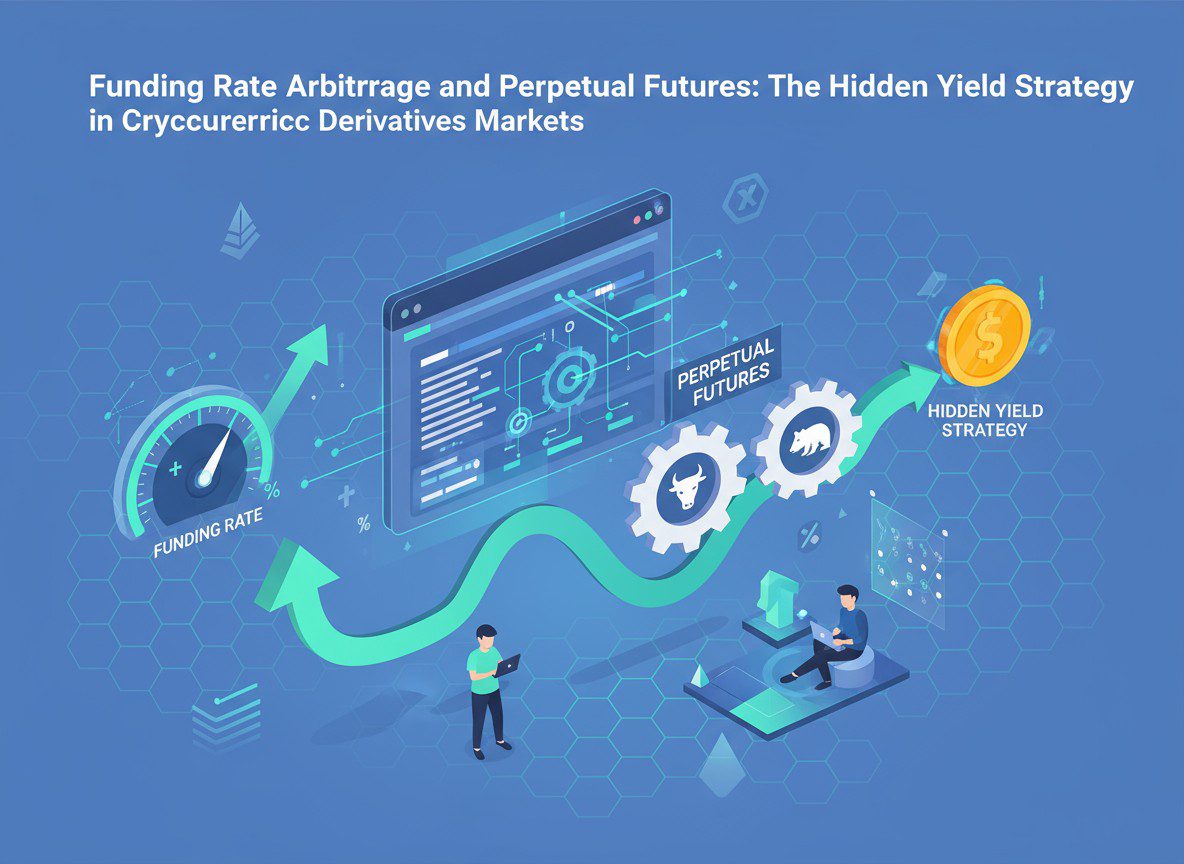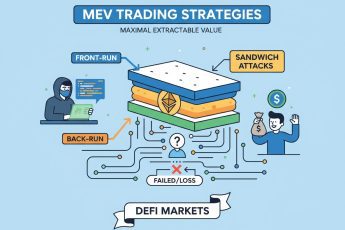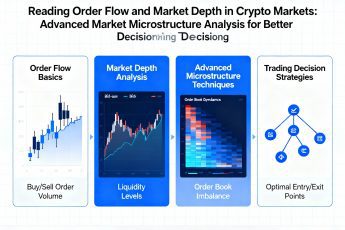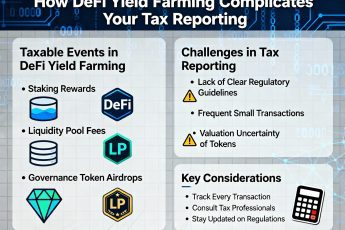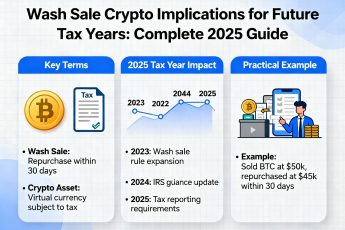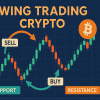- Discovering the Institutional Secret of Perpetual Futures Markets
- Understanding Perpetual Futures and the Funding Mechanism
- The Architecture of Perpetual Contracts
- The Mechanics of Funding Payments
- Market Psychology and Funding Rate Patterns
- The Complete Funding Rate Arbitrage Strategy
- Constructing the Market-Neutral Position
- Advanced Position Management Techniques
- Risk Management and Hedging Protocols
- Identifying and Capturing Premium Opportunities
- Scanning for Funding Rate Divergences
- Timing Entry and Exit Points
- Leveraging Market Events and Anomalies
- Technical Implementation and Infrastructure
- Building the Arbitrage System Architecture
- Handling Exchange APIs and Connectivity
- Data Storage and Analytics Requirements
- Advanced Strategies and Optimizations
- Cross-Exchange Funding Arbitrage
- Incorporating Options and Volatility Trading
- Machine Learning for Rate Prediction
- Risk Factors and Mitigation Strategies
- Understanding and Managing Basis Risk
- Exchange and Counterparty Risks
- Regulatory and Tax Implications
- Case Studies and Performance Analysis
- Historical Performance During Market Regimes
- Comparing Different Implementation Approaches
- Conclusion: Mastering the Art of Market-Neutral Yield
Discovering the Institutional Secret of Perpetual Futures Markets
Imagine a trading strategy that generates consistent returns regardless of whether Bitcoin rises or falls, a method that transforms the very mechanism designed to keep derivatives prices aligned with spot markets into a profit engine. This seemingly paradoxical approach exists, and institutional traders have quietly harvested these returns for years through funding rate arbitrage—one of the most misunderstood yet consistently profitable strategies in cryptocurrency markets.
To understand why this strategy remains relatively unknown despite its effectiveness, we need to first grasp how perpetual futures contracts fundamentally differ from traditional futures. Unlike conventional futures that expire on specific dates, perpetual contracts trade indefinitely, maintaining their connection to spot prices through an ingenious mechanism called the funding rate. This mechanism, designed as a market stabilizer, inadvertently creates systematic profit opportunities for traders who understand its deeper implications.
The beauty of funding rate arbitrage lies in its market neutrality. While most cryptocurrency traders obsess over predicting price direction, funding rate arbitrageurs remain agnostic to market movements. Their profits derive not from being right about where Bitcoin will trade tomorrow, but from understanding the structural dynamics that cause perpetual futures to periodically diverge from spot prices. This approach transforms volatile cryptocurrency markets into something resembling a fixed-income instrument, generating yields that often exceed traditional finance’s best risk-adjusted returns.
Think of the funding rate as a pendulum that constantly swings between favoring long and short positions. When market sentiment becomes excessively bullish, the pendulum swings to reward shorts. When bearish sentiment dominates, it compensates longs. By positioning themselves to capture these swings systematically, traders can extract consistent profits from the market’s natural breathing rhythm. The key lies in understanding when and why these swings occur, how to position for them efficiently, and most importantly, how to manage the various risks that can transform this “risk-free” strategy into a costly lesson in market dynamics.
Understanding Perpetual Futures and the Funding Mechanism
The Architecture of Perpetual Contracts
To truly appreciate funding rate arbitrage, we must first understand the elegant engineering behind perpetual futures contracts. Traditional futures contracts, like those for agricultural commodities, have predetermined expiration dates when physical delivery or cash settlement occurs. This expiration creates natural convergence between futures and spot prices as the delivery date approaches. But perpetual futures, invented by BitMEX in 2016, have no expiration date—they trade continuously, forever.
This creates an immediate problem: without expiration-driven convergence, what prevents perpetual futures prices from completely detaching from the underlying spot market? The answer is the funding rate mechanism, a periodic payment exchanged between long and short position holders. When the perpetual futures price trades above the spot price (indicating bullish sentiment), longs pay shorts. When it trades below (bearish sentiment), shorts pay longs. These payments occur every few hours, creating a financial incentive for traders to take positions that bring the perpetual price back in line with spot.
The mathematical formula for funding rates typically combines two components: a premium index and an interest rate component. The premium index measures the difference between the perpetual contract price and the underlying spot price, averaged over a specific period. The interest rate component reflects the cost of capital, usually set to a small fixed value like 0.01% per funding period. Most exchanges calculate this as:
Funding Rate = Premium Index + clamp(Interest Rate – Premium Index, -0.05%, 0.05%)
This clamping mechanism prevents extreme funding rates that could cause mass liquidations, while still maintaining sufficient economic incentive for price convergence. Understanding this formula helps traders predict funding rate changes and position themselves accordingly.
The Mechanics of Funding Payments
Let me walk you through exactly how funding payments work with a concrete example. Suppose you hold a long position of 1 BTC in perpetual futures on Binance, and the current funding rate is 0.01% (positive). At the funding timestamp (typically every 8 hours), you would pay 0.01% of your position value to traders holding short positions. If Bitcoin trades at $40,000, you’d pay $4 to shorts. Conversely, if the funding rate were -0.01% (negative), you’d receive $4 from shorts.
These payments might seem trivial individually, but their cumulative effect becomes substantial over time. A persistent 0.01% funding rate paid three times daily equals 0.03% per day, or roughly 11% annually—a significant cost for long-term holders but a attractive yield for those positioned to receive it. During extreme market conditions, funding rates can spike to 0.1% or higher per period, translating to over 100% annualized returns for arbitrageurs.
Table 1: Funding Rate Impact on Annual Returns
| Funding Rate (per 8h) | Daily Rate | Monthly Rate | Annual Rate | Strategy Position |
|---|---|---|---|---|
| 0.10% | 0.30% | 9.0% | 109.5% | Short Perp + Long Spot |
| 0.05% | 0.15% | 4.5% | 54.8% | Short Perp + Long Spot |
| 0.01% | 0.03% | 0.9% | 11.0% | Short Perp + Long Spot |
| 0.00% | 0.00% | 0.0% | 0.0% | No Opportunity |
| -0.01% | -0.03% | -0.9% | -11.0% | Long Perp + Short Spot |
| -0.05% | -0.15% | -4.5% | -54.8% | Long Perp + Short Spot |
The timing of funding payments creates interesting dynamics around the funding timestamp. Traders often adjust positions just before funding to avoid payments or capture them, causing temporary price distortions. Sophisticated arbitrageurs account for these microstructure effects in their execution algorithms, sometimes entering positions minutes before funding to minimize market impact and capture better entry prices.
Market Psychology and Funding Rate Patterns
Understanding the psychological drivers behind funding rates elevates this strategy from mechanical execution to intelligent prediction. Funding rates essentially measure market sentiment—the collective bullishness or bearishness of perpetual futures traders. During bull markets, retail traders predominantly use perpetual futures to gain leveraged long exposure, driving funding rates persistently positive. This creates a systematic wealth transfer from speculators to arbitrageurs who provide the balancing short interest.
Historical analysis reveals fascinating patterns in funding rate behavior. Major news events, like institutional adoption announcements or regulatory crackdowns, create funding rate spikes as traders rush to position themselves. These spikes often overshoot equilibrium, creating particularly profitable opportunities for patient arbitrageurs. For instance, when Tesla announced its Bitcoin purchase in February 2021, funding rates spiked above 0.2% per period across major exchanges, offering astute traders annualized returns exceeding 200% for several days.
The relationship between funding rates and subsequent price movements provides another layer of strategic depth. Extremely high funding rates often precede price corrections, as the cost of maintaining leveraged long positions becomes unsustainable. Conversely, deeply negative funding rates can signal oversold conditions and impending bounces. While funding rate arbitrage remains market neutral, understanding these dynamics helps traders optimize entry and exit timing, potentially capturing additional profits from favorable price movements.
The Complete Funding Rate Arbitrage Strategy
Constructing the Market-Neutral Position
The essence of funding rate arbitrage involves creating a market-neutral position that captures funding payments without exposure to price movements. The basic construction requires two offsetting positions: a short position in perpetual futures and an equivalent long position in the spot market. When Bitcoin rises, your spot position gains while your perpetual short loses an equal amount. When Bitcoin falls, the opposite occurs. The positions cancel each other’s price risk, leaving only the funding payments as your source of returns.
Let me illustrate with specific numbers to make this crystal clear. Suppose you have $100,000 in capital and Bitcoin trades at $40,000. You could buy 2.5 BTC on the spot market and simultaneously short 2.5 BTC in perpetual futures. If the funding rate is 0.01% and paid three times daily, you’d collect $30 per day (0.01% × $100,000 × 3) regardless of Bitcoin’s price movement. Over a month, this generates $900 in funding income—a 0.9% return on capital with theoretically zero directional risk.
However, the real-world implementation requires careful attention to several factors. First, you need sufficient capital to maintain both positions without leverage, as using leverage on the spot side introduces liquidation risk. Second, the spot and perpetual positions must be precisely balanced—any mismatch creates directional exposure. Third, you must account for the capital efficiency of your positions, as exchanges require margin for the perpetual short that reduces your deployable capital.
Advanced Position Management Techniques
Professional arbitrageurs employ sophisticated techniques to optimize their capital efficiency and returns. Rather than holding spot Bitcoin directly, many use stablecoins in lending protocols or yield-generating platforms to earn additional returns on their long leg. Platforms like Aave or Compound allow you to deposit USDC, borrow against it, and use the borrowed funds to purchase Bitcoin, effectively leveraging your spot position while maintaining liquidation buffers.
Table 2: Capital Efficiency Optimization Strategies
| Strategy Component | Basic Approach | Optimized Approach | Additional Yield | Risk Factor |
|---|---|---|---|---|
| Spot Position | Direct BTC Purchase | Wrapped BTC in DeFi | +2-5% APY | Smart Contract Risk |
| Collateral Management | Full Cash | Stablecoin Lending | +3-8% APY | Platform Risk |
| Exchange Selection | Single Venue | Multi-Exchange | +20-30% better rates | Operational Complexity |
| Position Sizing | Fixed Ratio | Dynamic Adjustment | +10-15% returns | Execution Risk |
| Funding Capture | Passive Collection | Active Trading | +25-40% returns | Market Risk |
Another optimization involves dynamically adjusting position sizes based on funding rate predictions. Rather than maintaining static positions, sophisticated systems increase exposure when funding rates are elevated and reduce it when rates normalize. This requires predictive models that analyze order flow, open interest changes, and historical patterns to forecast funding rate movements. Machine learning models trained on these features can achieve surprising accuracy in predicting short-term funding rate changes.
The choice of exchanges significantly impacts profitability. Different exchanges calculate funding rates using slightly different methodologies and time windows, creating opportunities for inter-exchange arbitrage. By maintaining positions across multiple venues and dynamically routing exposure to exchanges with the most favorable rates, traders can enhance returns by 20-30% compared to single-exchange strategies. However, this approach requires sophisticated infrastructure to manage multiple exchange APIs, handle various margin requirements, and ensure synchronized execution.
Risk Management and Hedging Protocols
While funding rate arbitrage appears risk-free in theory, practical implementation involves numerous risks that require careful management. The most immediate risk is basis risk—the possibility that spot and perpetual prices diverge beyond the funding rate compensation. During extreme volatility, perpetual futures can trade at significant premiums or discounts to spot, potentially creating losses that exceed funding income.
To quantify and manage basis risk, we need to understand its statistical properties. Historical analysis shows that basis typically follows a mean-reverting process with occasional fat-tailed events. The half-life of basis mean reversion averages 4-6 hours during normal markets but can extend to days during extreme conditions. This suggests that positions sized for normal conditions might experience substantial drawdowns during tail events. A robust risk management framework incorporates Value at Risk (VaR) calculations that account for these fat tails, typically using Cornish-Fisher expansion or extreme value theory rather than assuming normal distributions.
Execution risk presents another challenge, particularly during volatile periods when you need to rebalance positions. Slippage on large orders can erode profits, especially if you’re forced to rebalance during funding rate spikes when everyone else is trying to enter similar positions. Professional arbitrageurs address this through algorithmic execution that splits orders across time and uses limit orders whenever possible. They also maintain relationships with OTC desks for block trading capabilities during size adjustments.
Identifying and Capturing Premium Opportunities
Scanning for Funding Rate Divergences
The key to maximizing returns in funding rate arbitrage lies in identifying periods of extreme funding rate divergence across different assets and exchanges. This requires building comprehensive scanning systems that continuously monitor funding rates across multiple venues and trading pairs. While most traders focus solely on Bitcoin and Ethereum, smaller altcoins often exhibit more extreme funding rates due to concentrated speculative interest and lower arbitrage capital dedicated to these markets.
Consider developing a scoring system that ranks opportunities based on multiple factors. The most obvious factor is the absolute funding rate level, but this should be weighted by the asset’s liquidity, historical funding rate stability, and your ability to efficiently execute the arbitrage. A high funding rate on an illiquid altcoin might appear attractive but could prove impossible to capture profitably due to wide spreads and slippage.
Table 3: Opportunity Scoring Framework
| Scoring Factor | Weight | Calculation Method | Threshold Values | Impact on Strategy |
|---|---|---|---|---|
| Funding Rate Level | 35% | Current rate vs. historical average | >2 std dev = High opportunity | Primary signal |
| Liquidity Score | 25% | Order book depth / Daily volume | >$10M depth = Acceptable | Position size limit |
| Spread Cost | 20% | (Ask – Bid) / Mid price | <0.1% = Low friction | Execution viability |
| Historical Stability | 10% | Funding rate standard deviation | <0.05% = Stable | Risk assessment |
| Exchange Reliability | 10% | Uptime and withdrawal history | >99.9% = Reliable | Operational risk |
Advanced practitioners incorporate predictive elements into their scanning systems. By analyzing factors like open interest changes, volume patterns, and social sentiment, you can anticipate funding rate changes before they fully materialize. For instance, a sudden surge in open interest combined with rising spot prices often precedes funding rate increases, allowing you to establish positions before rates spike.
Timing Entry and Exit Points
The timing of position establishment significantly impacts overall returns. While the basic strategy suggests entering whenever funding rates are attractive, sophisticated analysis reveals optimal entry points that maximize risk-adjusted returns. The relationship between funding rates and market microstructure creates predictable patterns around funding timestamps that experienced traders exploit.
Let me explain the pre-funding dynamics that create these opportunities. In the hour before funding, traders who don’t want to pay high funding rates often close their positions, creating temporary price pressure in the opposite direction of the prevailing trend. If funding rates are highly positive (longs pay shorts), you’ll often see selling pressure in perpetuals as longs close positions. This temporarily depresses the perpetual price relative to spot, improving your entry price for the short perpetual position.
The mathematics of optimal entry timing involves balancing several competing factors. Earlier entry captures more funding periods but increases exposure to basis risk and potential funding rate changes. Later entry reduces these risks but might miss profitable periods. Dynamic programming approaches can solve for optimal entry times given assumptions about funding rate evolution and risk preferences. The Bellman equation for this problem considers the expected funding income, basis risk, and opportunity cost of capital at each potential entry point.
Leveraging Market Events and Anomalies
Certain market events create predictable funding rate anomalies that offer exceptional profit opportunities. Exchange maintenance windows, major economic announcements, and protocol upgrades often trigger funding rate dislocations as traders adjust positions in anticipation of volatility. Understanding these patterns allows you to position yourself ahead of the crowd, capturing enhanced returns during these special situations.
For example, options expiration dates create systematic patterns in funding rates. As monthly options approach expiration, dealers who sold options often need to hedge their gamma exposure by trading perpetual futures. This hedging flow can drive funding rates to extremes, particularly when large open interest concentrates at specific strike prices. By mapping options open interest and understanding dealer positioning, you can predict these funding rate spikes with reasonable accuracy.
Network events like Bitcoin halving or Ethereum upgrades create another category of opportunities. Historical analysis shows that funding rates exhibit elevated volatility and systematic biases around these events. Traders anticipating price movements establish leveraged positions days or weeks in advance, driving funding rates to extremes. Patient arbitrageurs who can maintain positions through these volatile periods often capture annualized returns exceeding 100% for several days or weeks.
Technical Implementation and Infrastructure
Building the Arbitrage System Architecture
Implementing a production-grade funding rate arbitrage system requires sophisticated technical architecture that can handle real-time data processing, risk management, and execution across multiple venues. The system must maintain precise position tracking, calculate real-time P&L including unrealized funding, and automatically rebalance positions when necessary. This level of complexity demands careful system design and robust error handling.
The core architecture typically consists of several interconnected modules. The data ingestion layer maintains WebSocket connections to multiple exchanges, normalizing their data formats into a unified schema. Real-time funding rates, mark prices, and index prices flow into a central message bus—often implemented using Apache Kafka or Redis Streams—that distributes data to various consuming services. This pub-sub architecture allows different components to process data independently while maintaining system coherence.
Table 4: System Architecture Components
| Component Layer | Primary Functions | Technology Stack | Scaling Considerations | Monitoring Metrics |
|---|---|---|---|---|
| Data Ingestion | WebSocket management, normalization | Python asyncio, Go | Horizontal scaling per exchange | Connection uptime, message latency |
| Message Bus | Event distribution, buffering | Kafka, Redis, NATS | Partitioned topics, cluster setup | Throughput, consumer lag |
| Strategy Engine | Signal generation, position sizing | Python, C++, Rust | Vertical scaling, GPU optional | Signal quality, execution lag |
| Risk Management | Exposure monitoring, limits | Real-time databases | In-memory caching critical | VaR, exposure metrics |
| Execution Gateway | Order routing, fill tracking | FIX engines, REST/WS | Connection pooling, retry logic | Fill rate, slippage |
| Monitoring Dashboard | System health, P&L tracking | Grafana, Custom React | Read replicas for queries | Update frequency, query time |
The strategy engine represents the system’s brain, continuously calculating optimal positions based on current funding rates, risk parameters, and available capital. This component must handle complex state management, tracking not just current positions but also pending orders, historical fills, and funding payment schedules. Modern implementations often use actor-based architectures where each trading pair operates as an independent actor, simplifying state management and improving system resilience.
Handling Exchange APIs and Connectivity
Exchange connectivity presents unique challenges in cryptocurrency markets due to varying API designs, rate limits, and reliability issues. Each exchange implements its own authentication mechanism, message format, and error codes, requiring extensive adaptation layers. Professional systems implement unified exchange adapters that abstract these differences, presenting a consistent interface to the strategy layer while handling exchange-specific quirks internally.
Rate limiting requires particular attention, as exceeding limits can result in temporary bans that disrupt trading. Sophisticated systems implement token bucket algorithms to track and respect rate limits, queuing requests when necessary. They also maintain multiple API keys per exchange, rotating between them to maximize available request capacity. Some exchanges offer dedicated infrastructure packages with enhanced limits for institutional traders, which become essential as trading volume grows.
Connection reliability in cryptocurrency markets falls far short of traditional finance standards. WebSocket connections drop frequently, REST endpoints experience timeouts, and entire exchanges occasionally become unavailable. Robust systems implement comprehensive failover mechanisms, including automatic reconnection with exponential backoff, message sequence tracking to detect missed updates, and graceful degradation when exchanges become unavailable. The system should continue operating profitably even when individual exchanges experience problems.
Data Storage and Analytics Requirements
The data requirements for funding rate arbitrage extend beyond simple price feeds. Systems must store and analyze funding rate history, basis evolution, position records, and execution quality metrics. This creates substantial data storage and processing requirements—a single trading pair can generate gigabytes of tick-level data daily when including order book snapshots and trade records.
Time-series databases like InfluxDB or TimescaleDB provide optimized storage for market data, supporting efficient queries across time ranges while compressing repetitive data. However, the analytical requirements often exceed what traditional databases can provide. Many firms implement lambda architectures, using stream processing for real-time analytics while batch processing systems like Apache Spark handle historical analysis and strategy backtesting.
The analytical pipeline must support both real-time monitoring and historical research. Real-time analytics track current strategy performance, risk metrics, and system health. Historical analytics identify patterns in funding rate behavior, optimize parameters, and validate strategy improvements. Machine learning pipelines require additional infrastructure, often leveraging GPU-accelerated computing for training models on vast historical datasets.
Advanced Strategies and Optimizations
Cross-Exchange Funding Arbitrage
While basic funding rate arbitrage operates within single exchanges, sophisticated traders exploit funding rate differentials across multiple venues. Different exchanges calculate funding rates using slightly different methodologies and time windows, creating persistent divergences that can be arbitraged. This cross-exchange approach requires more complex infrastructure but offers several advantages: higher returns through rate optimization, reduced concentration risk, and improved capital efficiency.
Consider how funding rates can diverge between Binance, Bybit, and OKX. Each exchange uses different price feeds for their index calculations and different parameters for funding rate computation. During volatile periods, these differences can create situations where one exchange shows positive funding while another shows negative funding for the same asset. By maintaining long positions on the negative funding exchange and shorts on the positive funding exchange, traders can collect funding from both sides simultaneously.
Table 5: Cross-Exchange Funding Rate Optimization Matrix
| Strategy Type | Complexity | Potential Returns | Capital Requirements | Key Risks |
|---|---|---|---|---|
| Single Exchange | Low | 10-30% APR | $10K minimum | Exchange risk concentration |
| Dual Exchange | Medium | 20-50% APR | $50K recommended | Transfer delays, basis risk |
| Multi-Exchange (3+) | High | 30-70% APR | $200K+ optimal | Operational complexity |
| Dynamic Routing | Very High | 40-100% APR | $500K+ recommended | System failures, correlation breaks |
| Hybrid with Lending | Extreme | 50-150% APR | $1M+ optimal | Multiple protocol risks |
The implementation of cross-exchange strategies requires sophisticated capital management. Funds must be distributed across exchanges to capture opportunities while maintaining sufficient reserves for rebalancing. This creates an optimization problem: too much capital on any single exchange reduces opportunity capture on others, while too little prevents taking meaningful positions. Dynamic capital allocation algorithms continuously solve this optimization, moving funds between exchanges based on expected opportunities and transfer costs.
Incorporating Options and Volatility Trading
Advanced practitioners combine funding rate arbitrage with options strategies to enhance returns and reduce risk. The relationship between funding rates and implied volatility creates opportunities for sophisticated multi-leg strategies. When funding rates are extremely high, implied volatility often rises as well, allowing traders to sell expensive options while maintaining their funding rate positions.
Let me illustrate with a concrete example. Suppose Bitcoin perpetual funding rates spike to 0.15% per period (indicating extreme bullish sentiment), and implied volatility for near-term options rises to 100% annualized. You could enhance your basic funding arbitrage by selling out-of-the-money call options, collecting additional premium from volatility sellers. The short calls provide extra income while partially hedging your short perpetual position if prices spike dramatically. This creates a more complex but potentially more profitable position structure.
The mathematical optimization of combined strategies involves multivariate optimization across different Greeks and funding expectations. The objective function might maximize expected return while constraining delta (price risk), gamma (convexity risk), and vega (volatility risk) within acceptable bounds. This creates a complex optimization problem that often requires numerical methods or machine learning approaches to solve efficiently.
Machine Learning for Rate Prediction
The application of machine learning to funding rate prediction represents the cutting edge of arbitrage strategy development. Rather than simply reacting to current funding rates, ML models can predict future rates based on market microstructure patterns, allowing traders to position themselves before rates move. This predictive capability transforms funding rate arbitrage from a passive yield strategy to an active alpha-generating system.
Feature engineering for funding rate prediction requires deep understanding of market dynamics. Useful features include order book imbalances, trade flow toxicity metrics, open interest changes, and cross-asset correlations. More exotic features might incorporate natural language processing of social media sentiment, blockchain metrics like exchange flows, or even weather patterns that affect mining hash rates and potentially influence trader behavior.
The choice of model architecture depends on the prediction horizon and required accuracy. For short-term predictions (next funding period), gradient boosting models like XGBoost or LightGBM often perform well, capturing non-linear relationships while remaining interpretable. For longer horizons, recurrent neural networks or transformer architectures can model sequential dependencies in funding rate evolution. Ensemble methods combining multiple models often provide the best results, as different architectures capture different aspects of market behavior.
Risk Factors and Mitigation Strategies
Understanding and Managing Basis Risk
Basis risk—the risk that spot and futures prices diverge beyond funding compensation—represents the primary threat to funding rate arbitrage strategies. While funding mechanisms generally keep prices aligned, extreme market conditions can cause persistent basis that erodes profitability. Understanding the statistical properties of basis risk and implementing appropriate hedging strategies determines the difference between consistent profits and devastating losses.
Historical analysis reveals that basis follows different dynamics during bull and bear markets. Bull markets typically exhibit positive basis (futures trading above spot) with occasional sharp compressions when leveraged longs get liquidated. Bear markets show negative basis with violent expansions when shorts cover. These asymmetric dynamics require different risk management approaches depending on market regime. Statistical models using regime-switching frameworks can help identify current market states and adjust risk parameters accordingly.
Table 6: Basis Risk Scenarios and Mitigation Strategies
| Market Scenario | Basis Behavior | Risk Level | Mitigation Strategy | Expected Impact |
|---|---|---|---|---|
| Normal Volatility | Mean-reverting, ±0.5% | Low | Standard position sizing | Minimal P&L impact |
| Liquidation Cascade | Rapid expansion to ±3% | High | Reduce position by 50% | Temporary drawdown |
| Exchange Disruption | Divergence to ±5% | Critical | Close positions on affected exchange | Avoid permanent loss |
| Regulatory Event | Persistent divergence | Extreme | Full strategy suspension | Capital preservation |
| Flash Crash | Instant ±10% spike | Severe | Automatic circuit breakers | Limit maximum loss |
Practical mitigation strategies include position limits based on historical basis volatility, automatic deleveraging when basis exceeds predetermined thresholds, and maintaining emergency liquidity for rapid position adjustments. Some traders implement basis momentum strategies that temporarily abandon market neutrality to profit from extreme basis movements, though this introduces directional risk that contradicts the strategy’s core principle.
Exchange and Counterparty Risks
The cryptocurrency ecosystem’s relative immaturity creates substantial counterparty risks that don’t exist in traditional markets. Exchange hacks, regulatory shutdowns, and operational failures can trap funds or create unhedged exposures. The collapse of FTX demonstrated how quickly seemingly stable exchanges can fail, potentially destroying arbitrage positions that depend on maintaining balanced exposures across venues.
Mitigating exchange risk requires diversification across multiple venues, but this creates operational complexity and capital inefficiency. Professional arbitrageurs often implement tiered exchange classifications based on security audits, regulatory compliance, and insurance coverage. Tier 1 exchanges might hold 40-50% of capital, Tier 2 exchanges 30-40%, and Tier 3 exchanges never more than 10-20%. Regular rebalancing ensures no single exchange becomes too large a concentration risk.
Beyond outright exchange failure, operational risks include withdrawal suspensions, margin requirement changes, and forced liquidations due to system errors. Robust monitoring systems must track not just position P&L but also operational metrics like withdrawal processing times, API error rates, and margin utilization. Abnormal patterns in these metrics often provide early warning of developing problems, allowing traders to reduce exposure before issues become critical.
Regulatory and Tax Implications
The regulatory landscape for cryptocurrency derivatives trading remains fluid and varies dramatically across jurisdictions. Some countries ban retail access to perpetual futures entirely, while others impose leverage limits or require extensive reporting. Funding rate arbitrage, while appearing to be low-risk yield generation, might be classified as sophisticated derivatives trading subject to professional investor requirements in certain jurisdictions.
Tax treatment of funding payments adds another layer of complexity. In many jurisdictions, funding payments might be treated as ordinary income rather than capital gains, creating different tax obligations than spot trading. The high frequency of funding payments (typically three times daily) creates thousands of taxable events annually, requiring sophisticated accounting systems to track and report correctly. Some traders structure their operations through offshore entities to optimize tax treatment, though this requires careful legal planning to ensure compliance.
The cross-border nature of cryptocurrency markets creates additional complications when funds move between exchanges in different jurisdictions. Anti-money laundering regulations require careful documentation of fund flows, particularly for large transfers. Professional arbitrageurs often maintain relationships with compliance specialists who ensure their operations meet regulatory requirements while maintaining operational efficiency.
Case Studies and Performance Analysis
Historical Performance During Market Regimes
Examining funding rate arbitrage performance across different market cycles provides valuable insights into strategy robustness and optimal implementation approaches. The strategy’s returns show strong negative correlation with market volatility—generating highest returns during exuberant bull markets and panic-driven crashes while producing modest returns during calm, ranging markets.
During the 2021 bull market peak, funding rates on Bitcoin perpetuals sustained levels above 0.05% per period for weeks, with spikes exceeding 0.2% during particularly frothy periods. Arbitrageurs who maintained positions throughout this period generated annualized returns exceeding 50% with minimal drawdowns. The key to capturing these returns was maintaining positions despite the temptation to close during temporary basis compressions that occurred during minor corrections.
The March 2020 COVID crash provides a contrasting case study. As markets crashed, funding rates turned deeply negative as traders aggressively shorted. However, the extreme volatility caused basis to blow out to unprecedented levels—exceeding 10% on some exchanges. Arbitrageurs who didn’t implement proper risk controls suffered devastating losses that erased months of accumulated profits. Those with automatic deleveraging and maximum loss limits preserved capital and profited handsomely from the subsequent normalization.
Table 7: Strategy Performance Across Market Cycles
| Period | Market Condition | Avg Funding Rate | Annualized Return | Max Drawdown | Sharpe Ratio |
|---|---|---|---|---|---|
| 2021 Q1 | Strong Bull | 0.048% | 52.3% | -4.2% | 3.8 |
| 2021 Q2 | Choppy Bull | 0.022% | 24.1% | -6.8% | 2.2 |
| 2021 Q3 | Recovery | 0.015% | 16.4% | -3.1% | 2.6 |
| 2021 Q4 | Bull Peak | 0.061% | 66.7% | -5.5% | 4.1 |
| 2022 Q1 | Bear Onset | -0.008% | 8.7% | -8.3% | 1.1 |
| 2022 Q2 | Crypto Winter | -0.012% | 13.1% | -11.2% | 0.9 |
Comparing Different Implementation Approaches
Not all funding rate arbitrage implementations are created equal. Comparing different approaches—from simple buy-and-hold arbitrage to sophisticated dynamic strategies—reveals dramatic performance differences. The simplest implementation might maintain static positions whenever funding rates exceed a threshold, while advanced systems dynamically adjust exposure based on predictive models and risk metrics.
A basic static strategy that enters positions when funding exceeds 0.01% and exits when it falls below 0.005% generated approximately 18% annual returns from 2019-2023 with a Sharpe ratio of 1.4. This approach requires minimal infrastructure and can be implemented by individual traders with basic programming skills. However, it misses opportunities during funding rate transitions and suffers during basis volatility events.
Dynamic strategies that adjust position sizing based on funding rate predictions and basis risk metrics achieved superior risk-adjusted returns. One documented approach using machine learning to predict funding rates 4 hours in advance and dynamically sizing positions based on prediction confidence generated 31% annual returns with a Sharpe ratio of 2.3 over the same period. The improved performance came from capturing funding rate transitions and reducing exposure during high-risk periods.
Conclusion: Mastering the Art of Market-Neutral Yield
Funding rate arbitrage represents one of cryptocurrency markets’ most elegant strategies—transforming a mechanism designed for price stability into a consistent profit engine. Through careful analysis of perpetual futures mechanics, systematic position management, and sophisticated risk control, traders can generate equity-like returns with bond-like volatility. The strategy’s market neutrality provides valuable portfolio diversification, generating returns uncorrelated with traditional directional trading approaches.
The journey from understanding basic funding rate mechanics to implementing profitable arbitrage systems requires dedication to mastering technical, operational, and risk management complexities. Success demands not just theoretical knowledge but practical experience navigating the unique challenges of cryptocurrency markets—from exchange failures to regulatory uncertainty. Yet for those who develop the necessary expertise and infrastructure, funding rate arbitrage offers a sustainable edge in increasingly efficient markets.
As cryptocurrency derivatives markets mature, funding rate opportunities will likely become more competitive, with tighter spreads and lower average rates. However, the fundamental mechanism ensuring perpetual-spot price convergence will persist, continuing to create opportunities for sophisticated arbitrageurs. The key to long-term success lies not in finding a static strategy but in continuously adapting to evolving market microstructure while maintaining robust risk management principles.
For traders beginning their funding rate arbitrage journey, start with small positions on liquid pairs like Bitcoin and Ethereum, focusing on understanding the mechanics before optimizing returns. Build systematic monitoring tools that track funding rates across exchanges, alert you to opportunities, and calculate risk metrics in real-time. Most importantly, respect the risks—what appears to be free money can quickly become expensive education if proper controls aren’t in place. With patience, discipline, and continuous learning, funding rate arbitrage can become a cornerstone of a sophisticated cryptocurrency trading operation, generating consistent returns through market cycles while others chase elusive price predictions.
